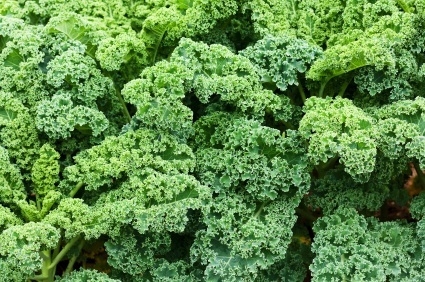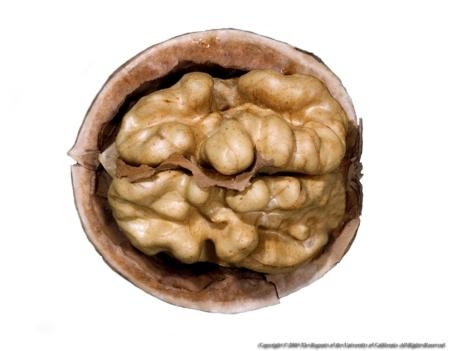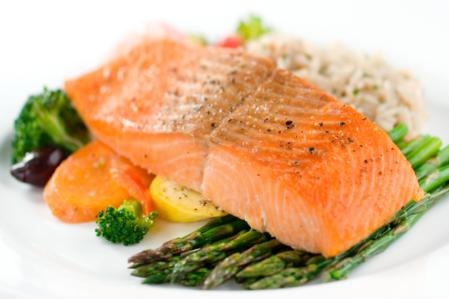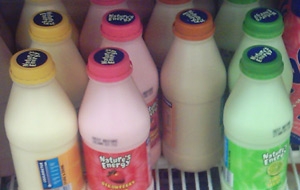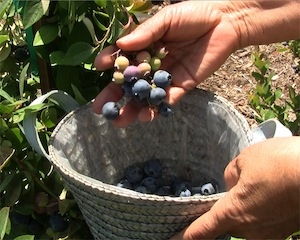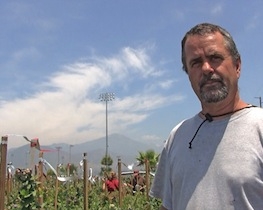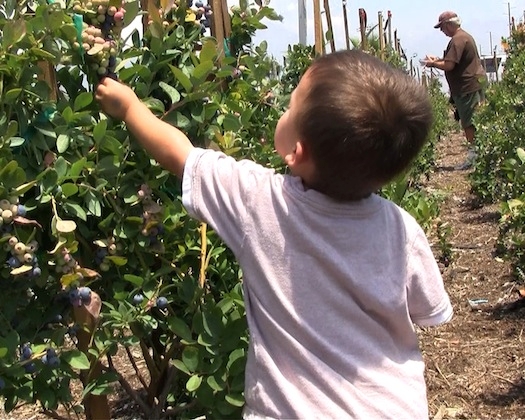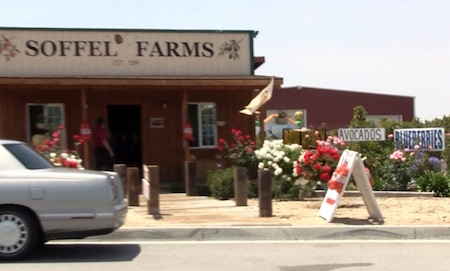UC Food Blog
New findings on benefits of “biofactors” in food
Can what we eat help fix what ails us? Research increasingly suggests the answer is “yes.” Many foods contain biofactors — biologically active compounds — that may prevent and treat illnesses including asthma, diabetes and heart disease, according to new studies from the UC Davis Center for Health and Nutrition Research (CHNR).
The upcoming July-September California Agriculture journal (to be posted by July 11) reports UC research into plant compounds (phytochemicals) that can help prevent or treat disease. The findings stem from pilot projects at the center, as well as other UC research. Articles focus on how micronutrients, biofactors and phytochemicals (plant compounds) can help reduce the risk of chronic diseases.
Biofactors are compounds in our food that affect us at the biochemical level and may ultimately benefit our health. For example, the omega-3 fatty acids in foods such as walnuts, flax seeds, kale and salmon may protect against a range of diseases associated with inflammation, including asthma and the hypertension-related inflammation that can damage kidneys. CHNR research suggests that omega-3 fatty acids could reduce asthma symptoms as well as kidney damage.
Phytochemicals and health. Epidemiological studies link particular diets to less risk of chronic diseases. Notably, the traditional Mediterranean diet — mostly vegetables, fruits and whole grains, with moderate amounts of nuts, olive oil and red wine — is associated with lower rates of heart disease, cancer, and Parkinson's and Alzheimer's diseases. However, it has yet to be firmly established that specific phytochemicals in our diets can protect against diseases. Nutritionists therefore advise eating a wide variety of plant-based foods rather than taking supplements.
That said, a number of phytochemicals do show promise in protecting against and even treating chronic diseases. For example, research shows that soybeans contain estrogen-like compounds called isoflavones that may protect against heart disease, and that compounds in olive oil and red wine may protect against heart disease and diabetes.
Mitochondrial nutrients and aging. The Mediterranean diet is rich in plant compounds that boost mitochondria (organelles in our cells that convert glucose and other nutrients into energy) and so are known as mitochondrial nutrients. When mitochondria are scarce or have genetic defects that keep them from working properly, this can generate toxic metabolites and damaging free radicals.
“Mitochondria are central to aging,” says UC Irvine aging expert Edward Sharman. “Improving their function may modulate or delay the onset of diseases related to aging, such as type 2 diabetes and age-related macular degeneration.” Mitochondrial dysfunction also plays a key role in chronic illnesses such as heart disease, type 2 diabetes and inflammatory diseases such as arthritis.
One of the most promising mitochondrial nutrients is hydroxytyrosol, which is abundant in the extra-virgin olive oil that provides most of the fat in the traditional Mediterranean diet. Moreover, the red wine that is integral to the Mediterranean diet also induces the body to produce more hydroxytyrosol.
A new essential nutrient? Another promising mitochondrial nutrient is pyrroloquinoline quinone (PQQ), which was first found in nitrogen-fixing soil bacteria and is now known to be ubiquitous.
“We’re exposed to PQQ all the time at low levels,” says CHNR co-director Robert Rucker, a UC Davis nutrition professor. “It can be derived from amino acids found in stellar dust, and stellar dust is what the earth is made of.”
While Escherichia coli and other common gut bacteria do not make PQQ, the soil bacteria provide it to the plants in our diet. Good sources include fermented soybeans, wine, tea and cocoa.
Animal studies show that PQQ affects health markedly. Rucker and his colleagues found that depriving rats of PQQ compromised their immune systems, and retarded their growth and reproductive rates. In contrast, restoring PQQ to their diets reversed these effects and returned them to good health. Moreover, PQQ stimulated nerve growth and counteracted aging in cultured cells.
Rucker and his colleagues found that, like hydroxytyrosol, PQQ increases the number of mitochondria in cells. “It’s also an extremely good antioxidant and anti-inflammatory agent,” he says.
Personalized medicine. Understanding what biofactors do in our bodies could ultimately lead to personalized medicine, where nutrition-based treatments are tailored to the particulars of each person’s biochemistry. This individual variation at the biochemical level may help explain the inconsistent outcomes of research on omega-3 fatty acids and inflammation.
“The studies are mixed,” says UC Davis pulmonologist Nicolas Kenyon. “Some have shown little effect and others have shown that omega-3 fatty acids can reduce arthritis and inflammation in blood vessels.”
This genotyping is targeted to DNA sequences associated with asthma and so is not comprehensive.
“Some people are nervous about genome-wide analysis, which is scary because none of us is perfect,” Kenyon says. “But people are more interested when the focus is specific screening that could increase their chances of treatment.”
Childhood obesity: Seeking solutions in San Diego
I recently switched from a small group practice to Kaiser when the rates for my old healthcare plan went up. My first visit to my new doctor was like something out of a happy-healthcare utopia: a farmer’s market out front hawked fresh peaches and plums; bright light streamed through tall windows as I found my way to a well-marked suite; a receptionist cheerily informed me there was no copay for this welcome visit.
But in my brief stay in the waiting room, I noticed there was an entire row of oversized chairs. And when I was ushered to the scale, in place of the typical stand with little black weights I found what can only be described as a freight scale — a large electronic platform at least 3 feet x 3 feet, built right into the floor.
The startling site of the industrial-strength scale brought home to me the severity of America’s obesity epidemic, and we are passing this problem on to our children to the extent that the First Lady Michelle Obama and the Surgeon General have both made childhood obesity one of their key public platforms.
The stats keep rolling in:
- One out of three children born in 2000 are projected to become diabetic in their lifetime.
- Heart disease risk factors now occur in one out of six children school-age kids.
Attendees at the Sixth Biennial Childhood Obesity Conference, convening this week in San Diego (June 28-30), will dig deep into the problems … and possible solutions.
Hot topics will include the newly released dietary guidelines: just last month the United States Department of Agriculture retired the pyramid in favor of a plate.
Patricia Crawford, a Cooperative Extension specialist and director of the UC Berkeley-based Atkins Center for Weight and Health (CWH), a co-sponsor of the conference, said the new guidelines are geared more towards obesity prevention, whereas in the past the focus was on making sure there were no nutrition gaps.
“The plate is very similar to one developed by California Cooperative Extension,” said Crawford. “California was an early adopter — along with New York City, the American Cancer Institute, Canada, and others."
Crawford said Cooperative Extension specialists and advisors tailored the plate concept to different ethnic groups.
“We realized early on that that the plate was a valuable teaching tool,” Crawford said.
The conference will also focus on the problem of junk-food advertisements targeting kids.
“Just last month the Federal Trade Commission came out with voluntary guidelines for industry,” said Crawford. "Public health advocates pushed for monitoring to see the degree to which marketing efforts change. This voluntary approach gives the industry a chance to change on their own before it’s mandated.”
Schools are taking the issue seriously, and California has been a leader for many years. Back in 2003 there was an unfunded mandate to replace profit-making junk food with better meals. Nothing happened.
Then in 2005, the Department of Education, with funding from Department of Agriculture, commissioned an evaluation to measure how much money schools will actually lose by removing the sales of cheap junk food. The CWH was the independent evaluator.
The finding? Surprise: most schools — over 80 percent — made more money when they got rid of those foods.
“It turned out that most money came from snacks. When kids quit buying junk, they moved to buying school meals, subsidized by the school meal program — and the profits came. In 2005 Governor Schwarzenegger signed legislation to limit high-sugar, high-fat snack foods in K-12 schools.
Crawford says more than half the states now have this type of legislation limiting these “competitive foods.”
Other hot topics in San Diego will be:
- Are all calories created equal? Studies say quality matters as much as quantity.
- National policy: Speakers address the Obama administration's unprecedented investment in prevention, and how it can be effective.
- Sugar-loaded beverages: National experts will be talking about newest research on how the sweet stuff is contributing to obesity.
Conference attendees can be inspired by findings that all the work in California is beginning to have an impact.
In a recently published article, the CWH showed that California is slowing the overall rate of childhood obesity. Crawford notes that legislation in 2005 to limit sugars and fats in school lunches correlates directly with the time that rates began to go down. The changes were slight, but significant.
“An individual losing a half pound at Weight Watchers may not be news, but when it comes to populations, a tiny shift indicates a tremendous public health impact,” Crawford said.
However, she notes that the disparities are more pronounced: certain groups are going down, and other high-risk groups rates are going up.
“We are beginning to have some traction, but we need to keep it up,” Crawford said.
In addition to the Atkins Center, the conference is co-sponsored by the California Department of Public Health, the University of California, Berkeley, the California Endowment, and Kaiser Permanente.

More information about the Childhood Obesity Conference is at http://www.childhood-obesity.net/.
Nothing plain about this UC Davis vanilla research
There is good news for those who are wild about all things vanilla – from ice cream to candy and even savory foods.
One of the world’s most popular flavors, vanilla comes from vanilla beans, which are grown in Madagascar, Mexico and other tropical regions. Unfortunately, vanilla farmers in these regions struggle to overcome low prices, a fungal disease epidemic, climate stress and environmental deterioration.
UC Davis scientist Sharman O’Neill is working to overcome some of these problems by carrying out genomic research to improve commercial vanilla plants and their sustainable cultivation in Madagascar.
Her efforts were recently recognized by the global food company General Mills, which named O’Neill the national winner of the General Mills Sustainability Challenge, a call for universities’ best ideas for reducing waste, encouraging sustainable consumption and using resources responsibly.
The honor comes with $200,000 to support the genomic vanilla research through O’Neill’s Vanilla Sustainability Project in UC Davis’ College of Biological Science.
The researchers aim to improve the genetic basis of the vanilla-bean crop so that vanilla farmers can overcome the problems posed by disease, climate stress, market uncertainties and environmental decline.
There is a lot at stake here because if these farmers abandon vanilla and change to other crops, the tropical forests, where the vanilla vines grow in compatible agroforestry systems, would likely be cut down. That would destabilize the critical habitat of innumerable plants and animals, including precious species of lemurs in northeastern Madagascar, the major vanilla-producing country.
"General Mills' goal is to maintain a strong, sustainable supply of high-quality vanilla beans," said Steve Peterson, director of sourcing sustainability at General Mills. "That's what this project is all about."
O’Neill’s vanilla research team involves an international group of scientists from the J. Craig Venter Institute in the United States; the French research center CIRAD on Réunion Island; the University of Antananarivo in Madagascar; the Instituto Nacional de Investigaciones Forestales, Agricolas y Pecuarias /SAGARPA in Mexico; and other international collaborators.
As part of the project, the scientists plan to use cutting-edge genomic sequencing and mapping technologies, in combination with traditional plant-breeding methods, to develop improved and new vanilla varieties that are hardier, more disease-resistant and offer enhanced flavor. A separate element of the project will also advance efforts to promote a more equitable model for sustainable vanilla cultivation with General Mills’ business partners.
The great flavored milk debate
Back in January, British chef and TV personality Jamie Oliver filled an old school bus with 57 tons of white sand in a parking lot in Carson, Calif. What was the purpose of this exercise, you might ask? The sand was meant to represent the amount of sugar in flavored milk. More specifically, the amount of sugar children in the Los Angeles Unified School District consume in a week’s time from flavored milk provided in their school lunches.
There has been much talk about flavored milk in recent months, and much of this debate has been fueled by Jamie Oliver who has a popular television show, Jamie Oliver’s Food Revolution, on ABC. His goal is simple: "To revolutionize school lunches to save the health of America’s next generation." Oliver launched a “sugary milk campaign” back in April, 2011. The purpose of the campaign is to ask schools to promote plain white milk instead of flavored milks. According to Oliver’s website, “chocolate milk has the same amount of sugar as a soft drink and just one additional soft drink per day increases a child’s obesity risk by 60 percent and is a major contributor to Type 2 diabetes.”
Well before Oliver emerged on the scene, people have debated the merits of offering flavored milk in the school lunch program. Chocolate (the most common), strawberry, vanilla and other interesting flavors are widely available in districts across the country. The milk provides essential nutrients, but with that comes added sugars that contribute extra calories to the diet – something most American children do not need.
Is there a place for flavored milk on the school lunch tray?
According to the American Dietetic Association, the Dairy Council and other health and nutrition organizations – the answer is yes.
Supporters of flavored milk in schools argue that it provides nine essential nutrients – unlike sodas and other sweetened beverages that offer no nutritional benefit besides extra calories.
According to the American Dietetic Association, leading health and nutrition organizations (including the American Academy of Family Physicians, American Academy of Pediatrics, American Heart Association, National Hispanic Medical Association, National Medical Association and School Nutrition Association) recognize the role that low-fat or fat free milk (including flavored milk) plays in helping kids achieve daily dairy serving recommendations. According to the ADA, kids will drink more milk when it’s flavored and kids drink less milk (and get fewer nutrients) when flavored milk is taken away.
The Diary Council offers an overview for school nutrition professionals in favor of flavored milk on the lunch tray. The Dairy Council of California argues that we cannot forget flavored milk has both natural sugars (lactose) and added sugar, and the amount of high-fructose corn syrup added to flavored milk is much less than the amount added to sugary beverages like soda or other processed foods. Additionally, some studies suggest that kids who drink flavored milk are less likely to consume soda and other sugary beverages, they consume more nutrients and are more likely to maintain a healthy body weight.
Where does LAUSD, the school district placed at the center of this debate, stand?
Last Tuesday, the board voted to eliminate flavored milk from its school lunch program. This new policy will affect 650,000 students who receive meals from LAUSD every day. This will spare flavored milk-drinking students an additional 6-12 grams of sugar (or 1 ½ - 3 teaspoons) a day, should they have chosen chocolate or strawberry milk over plain low-fat milk.
The burning question we all want to know the answer to now is, will LAUSD students switch over to low fat or fat free plain milk when chocolate or strawberry milk is no longer available in the fall? The answer will be very interesting and perhaps will put an end to the great flavored milk debate!
For foodies, being choosier is getting easier and fun
This season, for Southern California pick-your-own foodies, blueberries are among the latest and fastest growing offerings, thanks to the tenacity of small-scale farmers and the know-how provided by UC Agriculture and Natural Resources experts.
Although U-pick produce operations have been around for many years, farmers who let you hand-pick your blueberries was unheard of in this part of the state until recently.
We may have to thank UC Cooperative Extension farm advisor Manuel Jiménez, who's work on cultivars that he planted in 1997 at the UC Kearney Agricultural Research and Extension Center in Parlier has resulted in about 30 million pounds harvested in about 6,000 acres this year in California, mostly in the San Joaquín Valley.
A few days ago, my wife, Sylvia, and I decided to try our hand at picking our own berries at Soffel Farms in Redlands. It's one of the few local urban farms, or rather farms that became urban in the Inland Empire Area, which is San Bernardino and Riverside counties.
For the second year in a row, Soffel Farms is letting customers harvest as much as they want of its blueberries. This year, Ron Soffel is seeing people who drive more than a hundred miles to do just that.
"They don't see these around here, the closest are when you go up north to the San Joaquín Valley," he said of the blueberries as a new local crop.
By word of mouth, and of quite a few bloggers, locals and not so locals are showing up to pick the micro-nutrient rich blueberries, which many foodies see as magic pills in the fight against some types of cancer and obesity-related diseases like diabetes.
Of course, an incredible flavor helps too. For sure, pickers leave with a better understanding of what it's like to grow and harvest the foods that keep us healthy.
"Once they come up, and experience it, they come back," said Soffel.
Soffel Farms operates very much like other U-pick small-scale farms that are benefiting from agritourism, which UC small farm program has helped to develop to assist local growers. You check in, they give you a little basket and a couple of pointers:
- Walk carefully along the rows of bushes so do not damage the plants.
- Get only the ones that are purple; place the basket under the berries and gently roll your thumb over a berry to make it fall in the basket. (They do, just as if they were waiting for you!)
After you've picked enough, you go back and your berries are packed in 12 oz. plastic containers for which you pay $5 each.
I confess, my wife and I didn't wait until we got home to make sure we had gotten the most delicious blueberries we'd ever tasted! Once you taste a handpicked blueberry, it's hard not to eat some of the ones that should go into the basket.
I felt less guilty after seeing Soffel do the same as we spoke. Other visitors did it too, including a five-year-old who was accompanied by his grandparents, from San Diego. None of his blueberries went to a basket, but straight to his tummy.
"Purple!" he told me every time he put one in his mouth as we went along picking berries. He was the proverbial kid in a candy store. Thank goodness there was lots of that Mother Nature's candy.
As a consumer, I'm thankful that we have our own Manuel Jiménez, who tirelessly proved that blueberries could and should be added to the California cornucopia. And also for the determination of small growers like Soffel in keeping the agriculture tradition alive.
Although many farmers in California are now finding that blueberries are relatively easy to grow, Soffel says it's labor intensive. But it's helping him to keep his family tradition. Like many small-scale farmers, Soffel depends on direct sales. Adding blueberries to his pick-your-own operation, which includes a few acres of orange trees and avocados, is so far proving to be a good source of income, he said.
Soffel is typical of the decreasing number of local growers. They are constantly threatened by urbanization and its accompanying regulations. Soffel is a fifth generation farmer whose ancestors came from Oregon by wagon. The Stoffel Farms sign reads, "Established in 1914." Soffel says his family was among the pioneers that made the Redlands area famous for its oranges.
Most orange groves are gone and have been replaced by housing and commercial buildings; but Soffel and his family refuse to cut their roots to farming.
"I'll be a farmer forever," he told me.
I hope so. I'm waiting for word about his avocados being ready for picking.
(Photos: Alberto Hauffen)


